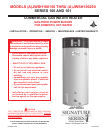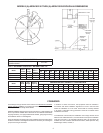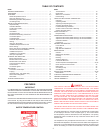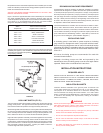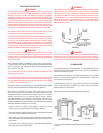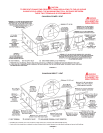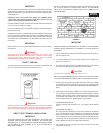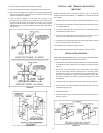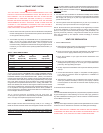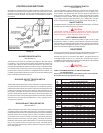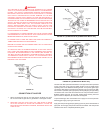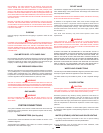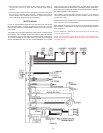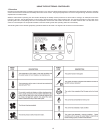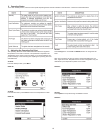
4
temperature be set for the lowest temperature which satises your hot water
needs. This will also provide the most energy efcient operation of the water
heater and minimize scale formation.
SETTING THE WATER HEATER TEMPERATURE AT 120°F/49°C WILL
REDUCE THE RISK OF SCALDS.
Figure 1 shows the approximate time-to-burn relationship for normal adult
skin. Short repeated heating cycles caused by small hot water uses can
cause temperatures at the point of use to exceed the thermostat setting by
up to 20°F/11°C. If you experience this type of use, you should consider
using lower temperature settings to reduce scald hazards.
Water Time to Produce 2nd & 3rd
Temperature Degree Burns on Adult Skin
180°F / 82°C Nearly instantaneous
170°F / 77°C Nearly instantaneous
160°F / 71°C About 1/2 second
150°F / 66°C About 1-1/2 seconds
140°F / 60°C Less than 5 seconds
130°F / 54°C About 30 seconds
120°F / 49°C More than 5 minutes
FIGURE 1.
Valves for reducing point-of-use temperature by mixing cold and hot water are
available (see Figure 2). Also available are inexpensive devices that attach
to faucets to limit hot water temperatures. Contact a licensed plumber or the
local plumbing authority.
FIGURE 2.
HIGH LIMIT SWITCH (E.C.O.)
The top immersion well of the dual bulb controller also contains the high limit
(energy cutoff) sensor. The high limit switch interrupts the main burner gas
ow should the water temperature reach approximately 202°F/94°C.
Should the high limit switch activate, the control system will automatically reset
the unit once the water temperature in the tank falls below 140°F/60°C. If the
unit is manually shut down and restarted, as long as the temperature in the
tank is lower than 160°F/71°C, the unit will reset and initiate operation.
High limit switch operation is the likely cause when higher than normal water
temperatures occur with a recurring need to restart the water heater. This
could be due to a malfunctioning thermostat allowing the gas valve to remain
open and the burner to continue ring even after water temperature in the
tank has already reached the set point. Contact your dealer or servicer if
continued high limit switch operation occurs.
DISHWASHING MACHINE REQUIREMENT
All dishwashing machines meeting the National Sanitation Foundation
requirements are designed to operate with water ow pressures between
15 and 25 pounds per square inch (103 Kpa and 173 Kpa). Flow pressures
above 25 pounds per square inch (173 Kpa), or below 15 pounds per square
inch (103 Kpa), will result in improperly sanitized dishes. Where pressures
are high, a water pressure reducing or ow regulating control valve should
be used in the 180°F (82°C) line to the dishwashing machine, and should
be adjusted to deliver water between these limits.
The National Sanitation Foundation also recommends circulation of 180°F
(82°C) water. Where this is done, the circulation should be very gentle so
that it does not cause any unnecessary turbulence inside the water heater.
The circulation should be just enough to provide 180°F (82°C) water at the
point of take-off to the dishwashing machine. Adjust ow by means of the
plug cock in the circulating line. (See installation diagrams.)
CIRCULATING PUMP
A circulating pump is used when a system requires a circulating
loop or there is a storage tank used in conjunction with the heater.
Refer to the piping diagrams at rear of manual for electrical hookup
information and install in accordance with the current edition of the
National Electrical Code, NFPA 70 or the Canadian Electrical Code,
CSA C22.1.
All bronze circulating pumps are recommended for used with
commercial water heaters.
Although circulating pumps are oiled and operated by the
manufacturer some circulating pumps must be oiled again before
operated. Please refer to manufacturer's instructions.
INSTALLATION INSTRUCTIONS
REQUIRED ABILITY
INSTALLATION OR SERVICE OF THIS WATER HEATER REQUIRES
ABILITY EQUIVALENT TO THAT OF A LICENSED TRADESMAN IN THE
FIELD INVOLVED. PLUMBING, AIR SUPPLY, VENTING, GAS SUPPLY
AND ELECTRICAL WORK ARE REQUIRED.
INSULATION BLANKETS
Insulation blankets available to the general public for external use
on gas water heaters are not approved for use on your water heater.
The purpose of an insulation blanket is to reduce the standby heat
loss encountered with storage tank water heaters. Your water heater
meets or exceeds the ASHRAE/IES 90.1 1999 standards with respect
to insulation and standby loss requirements, making an insulation
blanket unnecessary.
WARNING
Should you choose to apply an insulation blanket to this heater, you should
follow these instructions. Failure to follow these instructions can result in
re, asphyxiation, serious personal injury or death.
• Do not apply insulation to the top, or the upper 15" (38 cm) of the water
heater, as this will interfere with safe operation.
• Do not cover the temperature & pressure relief valve.
• Do not cover the instruction manual. Keep it on the side of the water
heater or nearby for future reference.
• Do obtain new labels from John Wood for placement on the blanket
directly over the existing labels.



